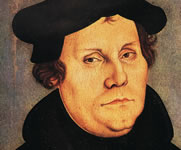Famous People
- Fairytale refuges for the fairytale king
- A paradise born of the Age of Enlightenment
- Fruits borne of strong women
- The “Sun King” of Saxony
- A romantic symbol of German history
- “My heart belongs to my garden”
- Royal life in modern times
- One masterpiece by two geniuses
- Monument to a passion for horticulture
- Count Bernadotte's flower island
- Preserving the cultural heritage
- Retreat for a king and philosopher
- A successful symphony of art and nature
- A Guelph family heirloom
One masterpiece by two geniuses
Balthasar Neumann (1687-1753) was one of the most influential architects of the baroque and rococo period. A former artilleryman, he was appointed Director of Construction in 1719 by prince bishop Schönbusch and commissioned to build the Würzburg Residenz Palace. He invited sceptics to test the strength of the huge self-supporting vaulted ceiling with cannon fire, but they decided to put their trust in his abilities. The ceiling fresco by Venetian artist Giovanni Battista Tiepolo is simply awe-inspiring. With this painting completed in 1752-1753, the Italian created a record-breaking masterpiece: at 677 square metres, it is the largest ceiling fresco in the world.
Würzburg Residenz Palace

Show on map »
Augustusburg Palace & Falkenlust hunting lodge, Brühl/Bonn
Show on map »
Veitshöchheim Palace & rococo garden
Situated only a few kilometres down the river Main from Würzburg is another late baroque gem. The hedge-lined pathways constantly reveal fresh glimpses of hedged compartments, arbours, pavilions, circular flowerbeds and the Parnasse figures in the large lake – one of the garden's highlights. Around 300 sculptures by Würzburg's court sculptors adorn the garden.
Show on map »
Show on map »
Travel Planner
Select an option...
Location
- Veitshöchheim Palace & rococo garden
- Würzburg Residenz Palace
- Augustusburg Palace & Falkenlust hunting lodge, Brühl/Bonn



